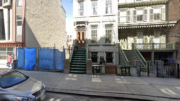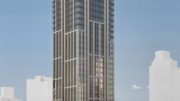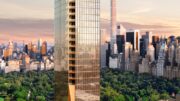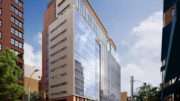Yesterday, we reported on yet another delay in the over year-long process of the city deciding whether to allow a landmark former church on the Upper West Side to be converted to condominiums. Now, we can report that the developer has withdrawn the plan for 361 Central Park West. That plan initially called for 39 units, but was scaled down to 35. The structure was built in 1903 as the First Church of Christ, Scientist of New York City. It received designation as an individual landmark in 1974.
A source tells YIMBY that the developer, listed as 361 Central Park West LLC, withdrew the plan in the face of likely rejection by the Board of Standards and Appeals, which had to approve waivers necessary for the conversion. The process at the BSA started in late March 2015, after an already lengthy process at the Landmarks Preservation Commission.
As for those waivers, the developer was seeking them those on the basis of five hardships. As we reported back in early December, the first was that there are unique physical conditions, including irregularity, narrowness or shallowness of lot size or shape, etc. make it impossible to comply with existing zoning. Second, that those physical conditions mean that there is no possibility of a reasonable return under current conditions. Third, that if a variance is granted, it “will not alter the essential character of the neighborhood or district.” Fourth, that the hardships are not the applicant’s fault. Fifth, that the variance sought is the minimum required to achieve reasonable return on the property.
At that time, attorney Michael Hiller, representing the Central Park West Neighbors Association, called the hardship application “considerable hubris.”
The conversion plan faced considerable community opposition and Hiller sees its withdrawal as a victory.
“Landmark buildings, especially churches, should never be converted to residential use. They are important public assets which help maintain our collective identity,” he told YIMBY Monday evening. “So, this is a victory, not only for the Upper West Side and the members of the Church’s Congregation who fought valiantly to preserve the Church, but for all New Yorkers who believe that our history is valuable and that landmark buildings should be preserved and protected.”
While this finally marks the conclusion of a very long process for this plan, it leaves the future of this wonderful structure up in the air. As we said yesterday, we do hope it gets put to some use in the near future. Located at 96th Street and Central Park West, directly across the street from Central Park, it’s a fantastic location for something, whether it’s another church, a museum, or something entirely else.
Subscribe to YIMBY’s daily e-mail
Follow YIMBYgram for real-time photo updates
Like YIMBY on Facebook
Follow YIMBY’s Twitter for the latest in YIMBYnews






Gotta say I agree with the NIMBYs on this one.
Agreed. It is a mis-use, on the part of the developer, to use the hardship clause. They knew what the restrictions were. This distinctive structure, of superior construction and materials, with its column free interior, can surely find another use. Perhaps with a different developer?
It is ominous that the variance application to enable the residential adaptation of this Church was withdrawn because the BSA signaled it would not grant the light and air variances requested. Unless the professionals involved in the case just bungled it completely (which I highly doubt given their ample experience and reputations in the field), this result is a regrettable sign of an unnecessary skepticism and restrictive leanings in an agency whose very reason for its existence is to preserve the constitutionality of our zoning scheme by providing relief from cookie cutter zoning restrictions never designed to apply to just such unique situations. The Mayor should take note of this situation, as facilitating the creation of housing of all types to address the demand tend to moderate prices, a goal he espouses. Now the fate of this great old building is seriously in doubt. Like others before it in which the overly restrictive web of land use regulation have prevented adaptive re-use, it will possibly fall into disrepair over many years of vacancy, and I wouldn’t blame the owner for letting that happen given the frustration of its years long good faith efforts without avail. On the other hand, I applaud the courageous Landmarks approval of the residential conversion and modest changes. That decision was correct and miraculous, and the BSA should have and could have found a way based upon the record of evidence before it to approve the variances, notwithstanding the predictable and incorrect NIMBY opposition.